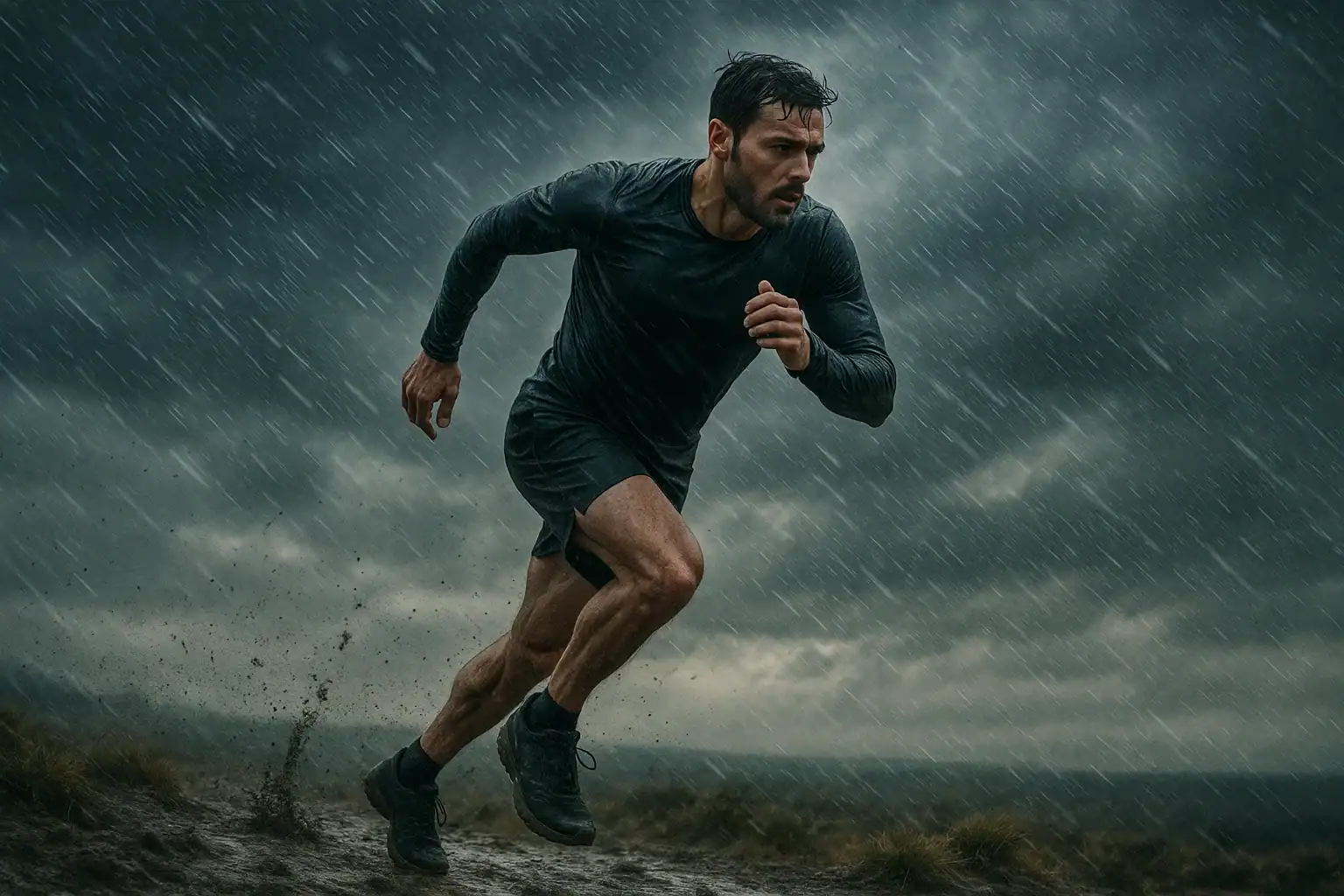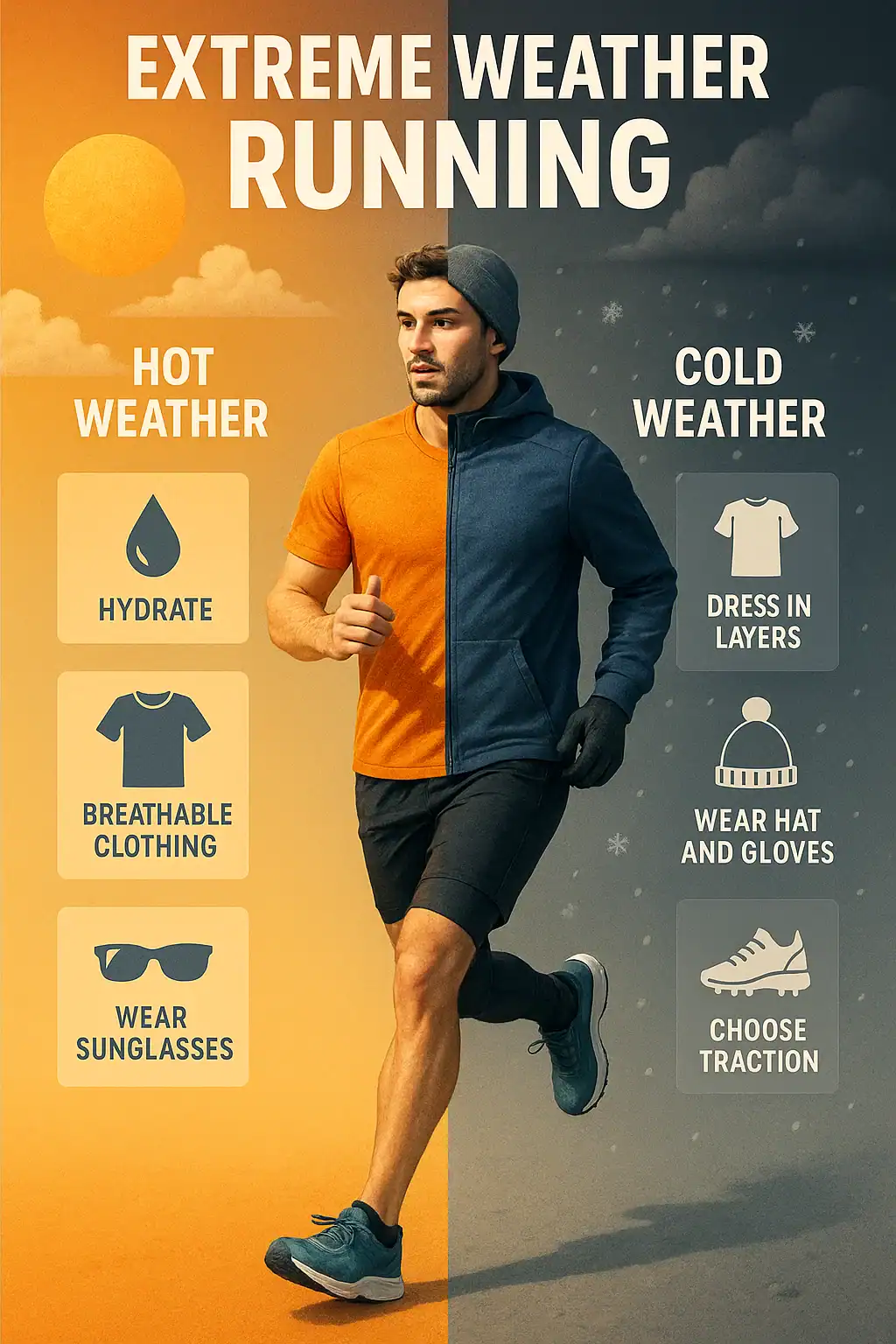How do you run in extreme weather? You run smart. You adjust your pace, gear, and mindset. This guide provides the exact strategies to run safely in heat, cold, rain, wind, and snow, based on 2026 sports science and biomechanics.
🔑 Key Takeaways
- Slow Down by 20-30%: Your pace must drop in heat or cold. Fighting this causes injury.
- Hydrate with Electrolytes: For runs over 60 minutes in heat, use products like Nuun or LMNT to prevent cramping.
- Master the 3-Layer System: A moisture-wicking base (Smartwool), insulating mid, and windproof outer shell (Gore-Tex) is non-negotiable for cold.
- Invest in Traction: On snow or ice, devices like Yaktrax Run or Kahtoola NANOspikes prevent falls.
- Check the AQI: If the Air Quality Index is above 100, run indoors. Lung damage is permanent.
- Face the Wind First: Always start your run into the headwind. The tailwind home is a mental victory.
- Your Ego is the Enemy: Adjust goals, take walk breaks, and know when to cancel. Smart runners last for decades.
Brutal Truths Before You Even Think About Lacing Up
- Your Body Isn’t a Superhero: You will be slower. It will feel harder. This is biology. Pushing your fair-weather pace in extremes leads to injury. The biggest mistake is refusing to adjust your ego to the thermometer.
- Gear is a Tool, Not Magic: Good gear makes the intolerable, tolerable. But no jacket turns a blizzard into a beach day. People often overspend on marginal gear gains while neglecting fundamental preparation.
- “Listen to Your Body” is a Commandment: That voice saying “this feels wrong” is usually right. Stubbornness in the face of physical distress is dangerous.
- Misery is Mostly Mental (But Not Entirely): Embrace the challenge. But don’t let “mental toughness” become an excuse to ignore genuine physical limits or safety warnings.
The Nitty-Gritty: How Your Body Wages War (and Sometimes Loses)
Before strategizing, understand your body is working overtime.
- Heat Hell: Your cardiovascular system diverts blood to your skin to cool you. Your muscles get less. Your heart rate spikes at a “normal” pace. That’s why.
- Arctic Antics: Your body pulls blood from extremities (fingers, toes) to keep your core warm. Smart for survival, bad for avoiding frostbite. Acknowledging these limits is intelligence. You wouldn’t expect your car to perform the same in a sandstorm. Treat your body with the same mechanical respect. Effective breathing techniques become critical when your system is under duress.
The Heat Monster: Outsmarting the Sizzle & Swelter
Running in oppressive heat feels like jogging through molasses in a sauna suit. It’s dangerous if treated casually.
STOP. THE. RUN. IF:
- You feel dizzy, confused, or lose your bearings (key signs of heatstroke).
- You are about to vomit.
- Your skin is cool/clammy OR hot/dry (especially if you’ve stopped sweating).
- A pounding headache develops.
- Muscle cramps are crippling, not just a niggle.
- Your heart rate is dangerously high and doesn’t match your effort.
My No-BS Heat Survival Kit:
- Hydration is a Lifestyle:
- Critical Debunk: “Loading up” on water an hour before is mostly nonsense. Consistent, day-long hydration primes your system.
- Electrolytes are Essential: After 60 minutes in heat, water alone won’t cut it. You lose salt. Skip sugary sports drinks. Use electrolyte tabs like Nuun or LMNT. Understanding nutrition and hydration science prevents bonking.
- Sip. Don’t. Gulp. Think hummingbird, not camel.
- Embrace the Dark: Run early morning or late evening. Running under the midday summer sun is asking for a beatdown.
- Dress to Cool:
- Light colors, loose fits, breathable fabrics (polyester, nylon). Dark colors are heat magnets. Cotton is a heavy, soggy enemy.
- This is not the time for modesty. Shorter shorts and lightweight singlets improve cooling. Less fabric is often more.
- Sun Protection is Vital: A brimmed hat, UV-blocking sunglasses, and high-SPF sweat-resistant sunscreen. Sunburn hampers your body’s cooling.
- Kill Your Ego: Slow down by 20-30%. Walk the uphills. Your cool-weather pace is irrelevant. Trying to maintain it is the biggest mistake runners make. Sensible adjustments are crucial to prevent common injuries.
- Acclimatization Takes Time: If you must race in heat, introduce your body to it gradually over 2-3 weeks. Not a couple of runs the week before.
Winter’s Bite: How to Run When It’s Freezing (and Not Hate Life)
Winter runs have raw beauty, if you’re not a human popsicle. Wrong prep leads to frostbite or hypothermia.
Cold’s Treachery – Don’t Ignore These:
- Numbness or waxy-looking skin on extremities (frostnip).
- Uncontrollable shivering (early hypothermia).
- Slurred speech, confusion, clumsiness (advancing hypothermia – get help NOW).
- Deep, bone-level fatigue.
My Battle-Tested Cold Weather Protocol:
- Master the 3-Layer System:
- Base Layer (Skin Contact): Snug, moisture-wicking merino wool (Smartwool) or synthetic (Patagonia Capilene). Cotton here is a failure. Its job: move sweat OFF your skin.
- Mid-Layer (Insulation): Fleece or technical insulation (Polartec Alpha). Traps body heat. Skip this on milder days if you run hot.
- Outer Layer (The Shield): Wind-resistant is key. Water-resistant/proof and breathable (Gore-Tex). Non-breathable shells create a sweaty swamp.
- Start slightly cool. You’ll warm up. Overdressing makes you a sweaty, then freezing, mess.
- Guard Your Extremities:
- Head & Ears: A hat covering ears is non-negotiable. A neck gaiter (Buff) is a secret weapon.
- Hands: Insulated, windproof gloves or mittens (mittens are warmer).
- Feet: Quality wool-blend socks (Darn Tough). Don’t go so thick your shoes restrict blood flow.
- Respect Wind Chill: The “feels like” temperature is what your body fights. Plan your route to have the wind at your back on the return leg.
- Footwear is Grip:
- Cold and clear: Your usual shoes with warmer socks.
- Snow/slush/ice: Use trail shoes with aggressive lugs (Salomon Speedcross). For ice, use traction devices (Yaktrax Run). A slip can end your season.
- Be a Human Lighthouse: Winter means low light. Reflective gear and a headlamp (Petzl) are survival tools. Assume every driver is distracted.
- Warm Up Indoors: Do dynamic movements inside first. Get blood flowing before you hit the cold. Never static stretch cold muscles.
The Invisible Enemy: Conquering Soul-Crushing Wind
Wind saps your will and makes mild temperatures feel arctic.
- Face the Fury First: On an out-and-back, run into the wind on the way out. The tailwind home feels like you’ve sprouted wings. This mental trick is gold.
- Protect Your Ears: Wind howling in your ears is fatiguing. A hat or headband covering them is a must.
- Aerodynamics Matter: A snugger outer layer cuts through wind better than a billowy jacket.
- Expect a Fight on Exposed Routes: On open roads or at altitude, wind is your main sparring partner. Factor its effect into your effort.
Rain: Friend or Foe? (Spoiler: Depends on Your Gear & Attitude)

A rainy run can be cleansing or a chafe-filled misery.
- Waterproof vs. Water-Resistant:
- Waterproof jacket (Gore-Tex): Keeps rain out. Can trap sweat unless it’s high-end and breathable.
- Water-resistant shell: Fends off light drizzle. Breathes better. Fails in a downpour.
- For most non-freezing rain, I choose a highly water-resistant, breathable shell and accept getting damp. A non-breathable “waterproof” jacket makes you wet from sweat, which is worse. In cold rain, waterproofness is paramount to prevent hypothermia.
- Brimmed Hat > Hood: Keeps rain off your face and out of your eyes more effectively.
- Slippery Footwear: Some love GORE-TEX shoes. My take: If water gets in over the ankle, they become foot-bathtubs that don’t drain. I prefer shoes that drain quickly.
- Prevent Chafe: Lube up (Body Glide). Wet fabric + friction = pain.
- Be Extra Visible: Rain reduces driver visibility. Bright colors and lights are non-negotiable.
- Change Immediately Post-Run: Get out of wet clothes fast. A chill sets in quickly.
When the Air Itself is a Pollutant: Running in Iffy Air Quality
Wildfire smoke, smog, and high pollen hurt you.
- AQI is Your Oracle: Check the Air Quality Index (AirNow.gov). Learn what the numbers mean.
- When in Doubt, Stay Out: Your lungs are not replaceable. If the AQI is above 100 (Unhealthy for Sensitive Groups), hit the treadmill. It’s not worth long-term damage.
- Avoid Traffic: If AQI is borderline, run early AM in parks, away from congested roads.
- Masks for Exercise? Specialized masks (Respro) can filter pollutants. They also make breathing during exertion very difficult. This is a personal call based on AQI and sensitivity.
The Slippery Slope: Navigating Snow & Ice (Without Ending Up on Your Butt)
Snowy runs are serene. Icy runs are an orthopedic hazard.
- Footwear is Life Insurance:
- Light Snow/Slush: Trail shoes with decent lugs.
- Packed Snow/Any Ice: Use traction devices (Yaktrax Run, Kahtoola MICROspikes). A fall on ice can be catastrophic.
- Deep Snow: This is high-intensity slogging. Expect a massive pace drop.
- Shorten Your Stride: Better balance, less chance of a fall. Focus on improving your running form for stability.
- Assume All Snow Hides Ice: Because it often does.
- Blizzards & Ice Storms? Common sense must override your training plan. Sometimes, the smartest run is the one you skip.
Special Note: Trail Running – Wild Beauty, Wilder Risks
Trail running in extreme weather amplifies every challenge. That rocky trail becomes a slip-and-slide. Mountain weather is fickle. Over-prepare. Check multiple forecasts. Tell someone your exact route and ETA. Carry more layers, food, and water than you need. Wear proper trail shoes with aggressive traction (Altra Lone Peak). This isn’t the place for road racers.
Beyond the Run: The Stuff That Really Makes a Difference

Gear: Smart Investment, Not Hoarding
You don’t need the priciest version of everything. But invest in quality technical fabrics for core items: base layers, a good shell, socks, and proper shoes. People buy expensive GPS watches but skimp on socks, then wonder why they get blisters. Prioritize function. Essential outdoor running gear is about safety and comfort.
Safety: A Requirement
- Tell Someone: Especially for blizzard runs or remote trails.
- Your Phone is a Lifeline: Keep it charged and protected.
- Carry ID: A small thing that could be a big deal.
- Be Visible: Reflective gear, bright colors, lights. Don’t assume anyone sees you. Internalize these running safety essentials.
Post-Run Recovery: The Unsexy Hero
Extreme weather beats you up more. Skimp on recovery, and you’ll pay.
- Temperature Management: Warm, dry clothes immediately after a cold run. A cool shower after a scorcher.
- Refuel & Rehydrate: Protein, carbs, fluids, electrolytes. Don’t neglect proper pre and post-run nutrition.
- Listen to Your Body’s Report: You might need more rest. Ignoring this turns niggles into injuries. Understand the role of rest and recovery.
Races in “Character Building” Weather
- Throw Your Time Goals Away: Survival and smart effort management are your new A-goals.
- Pack for All Seasons: Race morning weather can change rapidly.
- Know the Course: Identify where aid stations are and where the wind will hit hardest.
- DNS/DNF are Brave Acronyms: “Did Not Start” or “Did Not Finish.” There is zero shame in a smart safety call. Hypothermia isn’t worth a finisher’s medal.
A Nod to Runners 40+
Our minds write checks our bodies can’t always cash as easily.
- Warm-ups Are Mandatory: Especially in cold. Give your engine time.
- Internal Thermostats Get Quirky: We’re less efficient at temperature regulation. Be vigilant.
- Hydrate by the Clock: Thirst sensation becomes less reliable.
- Recovery is a Necessity: It takes longer. Be kind to yourself. Explore specific advice for running for seniors.
Conclusion
Running in extreme weather builds resilience, but it’s not about proving toughness. It’s about being an intelligent, adaptable athlete. Respect the elements more than your ego. Prioritize your long-term ability to run over any single, miserable workout.
The smartest decision is sometimes the treadmill, a cross-training day, or the couch. Learning to identify that line is the most critical skill of all.
Now, gear up intelligently, listen to the forecast and your gut, and make the elements your training partner. Run smart, and you’ll run for life.
❓ Frequently Asked Questions
What is the most dangerous weather for running?
Extreme heat poses the fastest, most acute danger, leading to heatstroke, which is a medical emergency. However, extreme cold with high wind chill can lead to rapid-onset frostbite and hypothermia. Always check both temperature and “feels like” conditions before heading out.
How much should I slow down in hot weather?
Plan to slow your pace by 20-30% for every 10°F above 60°F. For example, if your easy pace is 9:00/mile at 60°F, expect to run 10:48-11:42/mile at 80°F. Focus on perceived effort, not pace.
Are GORE-TEX running shoes worth it for rain?
They are effective for light rain and puddles. The trade-off is breathability and drainage. If water gets in over the ankle (from deep puddles or rain), it can’t escape. Many experienced runners prefer fast-draining non-waterproof shoes and simply wear merino wool socks to stay warm when wet.
What AQI level is unsafe for running?
According to 2026 EPA guidelines, consider moving indoors if the AQI is above 100 (“Unhealthy for Sensitive Groups”). At 150+ (“Unhealthy”), all runners should avoid outdoor exertion. Lung irritation and long-term damage are real risks from particulate matter (PM2.5).
What’s the single best piece of gear for cold weather running?
A quality merino wool or synthetic moisture-wicking base layer. It manages sweat, which is the primary cause of getting cold. If your base layer is cotton, you will get wet, chilled, and miserable regardless of what you wear over it.
References
- Cold Weather Running – Road Runners Club of America
- Running in the Heat Guide – Fleet Feet
- Running in the Heat – Runner’s World
- Runner’s Guide to Heat – McMillan Running
- Winter Running Tips – REI Expert Advice
- Cold Weather Running – NYRR
- Air Quality Index (AQI) – AirNow.gov
- Heat Acclimatization & Performance – Medicine & Science in Sports & Exercise (2026)
Alexios Papaioannou
Mission: To strip away marketing hype through engineering-grade stress testing. Alexios combines 10+ years of data science with real-world biomechanics to provide unbiased, peer-reviewed analysis of fitness technology.
